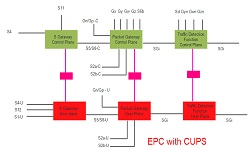ACLR / ACPR
Adjacent Channel Power Ratio ACLR stands for Adjacent Channel Leakage Ratio
ACPR stands for Adjacent Channel Power Ratio and ACLR stands for Adjacent Channel Leakage Ratio. Though the name is different, both terms are used interchangeably to represent the same thing. It is the ratio of power between the main channel and those channels around the main channel as shown below:
ACLR or ACPR is measured in the units of dBc, here “c” is used after dB because the adjacent channel power is measured with respect to main carrier which is at the center.
ACLR in LTE
The 3GPP specifications for LTE define ACLR as the ratio of the filtered mean power centered on the assigned channel frequency to the filtered mean power centered on an adjacent channel frequency.
Different limits and measurement filters are specified for E-UTRA and UTRA adjacent channels, and are provided for both paired spectrum (FDD) and unpaired spectrum (TDD) operation.
Given the extensive number of complex transmitter configurations that can be used to test transmitter performance, LTE specifies a series of downlink signal configurations known as E-UTRA test models (E-TM) for testing the eNB. The models are grouped into three classes: E-TM1, E-TM2 and E-TM3. The first and third classes are further subdivided into E-TM1.1, E-TM1.2, E-TM3.1, E-TM3.2, and E-TM3.3.
ACLR is tested using test models E-TM1.1 and E-TM1.2.




